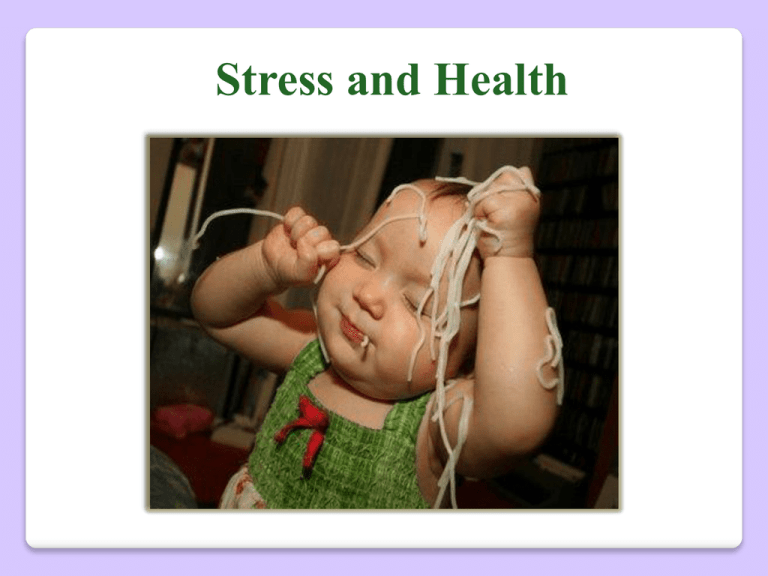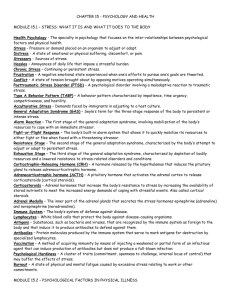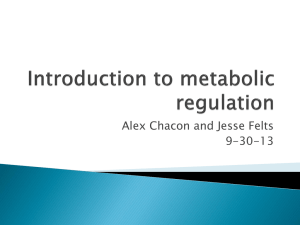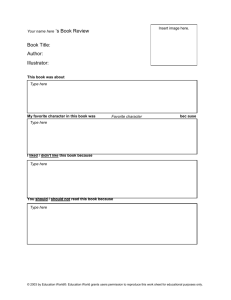What is Stress?
advertisement

Stress and Health Early Warning Signs of Exhaustion Stage Headaches GI disturbances Skin rashes & hives Dizziness Fatigue Hypertension Aggravation of: arthritis, colitis, asthma, ulcers, diabetes How Stress Affects Health Cancer ◦ Not clearly associated with onset, but is associated with acceleration of the disease Coronary Heart Disease ◦ Increased risk in high stress jobs (Pickering et al, 1996) ◦ Increased risk among employed mothers (Haynes et al, 1980) Psychoneuroimmunology ◦ Animal studies ◦ Medical students have decreased immune function around exam periods (Glaser et al, 1986) If you don’t want to be ill... ...Find Solutions. Negative people do not find solutions, they enlarge problems. They prefer gossip, and pessimism. A bee is small, but produces one of the sweetest things that exist. We are what we think. The negative thought generates negative energy that is transformed into illness. What is Stress? Psychological state associated with physiological and hormonal changes caused by conflict, trauma, or other disruptive influences (stressors) Types of Stress Positive Stress (USTRESS) Results to: • Heightened concentration • Increased performance • Energized motion Negative Stress ( ) Results to: • Loss of motivation • Reduces effectiveness • Physical, mental, and behavioural problems DISTRESS Stressors Traumatic events outside the usual range of human experience Uncontrollable events Unpredictable events Events that challenge the limits of our capabilities & self-concept Internal conflicts Stress Responses Physiological Behavioural Higher blood pressure Rapid shallow breathing Increased heart rate Dilation of pupils Muscle tension Dry mouth Sleep disturbance Use of alcohol/drugs Absenteeism Aggression STRESS Emotional Depression/anxiety Irritability Crying Suicide Loss of humour Biochemical Cognitive Lack of concentration Negative thoughts Worrying Poor Memory Increased metabolic rate Altered hormone levels (adrenaline, cortisol, ACTH) Altered endorphin levels Post-Traumatic Stress Disorder • Numbness to world, estrangement from others, lack of interest in activities • Relive trauma repeatedly in memories and dreams • Sleep disturbance, decreased concentration, overalertness • Can last for years • Correlates = substance abuse, violence, interpersonal problems In the past year alone the number of diagnosed cases in the military jumped 50%- and that’s just diagnosed cases. Studies estimate that 1 in every 5 military personnel returning from Iraq and Afghanistan has PTSD. 20 % of the soldiers who have been deployed in the past 6 years have PTSD. That’s over 300,000. 17% of combat troops are women; 71% of female military personnel develop PTSD due to sexual assault within the ranks. • PTSD is classified in the DSM-IV after the Vietnam War. How does Fight or Flight work? 1. The hypothalamus activations the sympathetic and adrenal cortical system. The sympathetic uses nerve pathways to initiate reactions in the body. The Adrenal system uses the blood stream. This causes the fight or flight response. What is going on in the sympathetic nervous system? 1. Body speeds up, tenses up becomes very alert! If there is a bugular at your door you have to take action fast. The Sympathtic system sends out impulses to glands and muscles and tells the adrenal medulla to release EPINEPHRINE (ADRENALINE) and NOREPINEPHRINE (NORADRENALINE) into the blood streem. Increases heart rate and blood pressure. At the same time, the hypothalamus release corticotrophin into the pituitary gland, activating the adrenal-cortical system and secretes the hormone ACTH. The ACTH goes through the bloodstream and to the adrenal cortex which activates the release of 30 different hormones that get the body prepared to deal with The sudden flood of epinephrine, norepinephrine and dozens of other hormones causes changes in the body that include: heart rate and blood pressure increase pupils dilate to take in as much light as possible veins in skin constrict to send more blood to major muscle groups (responsible for the "chill" sometimes associated with fear -- less blood in the skin to keep it warm) muscles tense up, energized blood-glucose level increases by adrenaline and glucose (responsible for goose bumps -- when tiny muscles attached to each hair on surface of skin tense up, the hairs are forced upright, pulling skin with them) smooth muscle relaxes in order to allow more oxygen into the lungs nonessential systems (like digestion and immune system) shut down to allow more energy for emergency functions trouble focusing on small tasks (brain is directed to focus only on big picture in order to determine where threat is coming from) Our stress response is ill-equipped to deal with modern stressors General Adaptation Syndrome Hans Selye (1978) Alarm Reaction Stage (SNS activation and stress hormone discharge) Resistance Stage (‘full war effort’) Exhaustion Stage (resistance fades as adaptive processes fail) General Adaptation Syndrome Stages & Phases Under stress, a person may have a general response to the stressful stimuli. One of the responses can be the general adaptation syndrome. General adaptation syndrome involves three phases or stages. •Alarm Phase This stage is marked by the activation of the “fight and flight” response, the release of catecholamines and the release of the adrenocorticotropic hormone. This stage is also characterized by a defensive and antiinflammatory response. Prolonged exposure to the alarm phase is lethal to the human system, and so the body enters to another stage. •Resistance Phase In this stage, the adaptation to the stressor or noxious stimuli occurs. This stage is still marked by an increase in cortisol levels (from the release of adrenocorticotropic hormone). •Exhaustion Phase Prolonged exposure to stress results to the stage of exhaustion, this stage has dangerous effects to the human body particularly the digestive, immune and circulatory system. When a person is left untreated, and stays at this stage for a prolonged period of time, the result can be death. Conflicts Approach - Approach Conflict ◦ Involves two alternatives, choose between two things we want to do. I could go to MIT or Oxford Approach-Avoidance Conflict one part of the situation is attractive and the other one you want to run away. Want to go out with someone but afraid you won’t be liked. You can go to jail or college Avoidance-Avoidance Conflict involves two unattractive alternatives You can go to federal or state prison Double Approach-Avoidance Conflict-they are both good and bad parts I could go to Alabama but I would be away from my family, or I could go NACC and be close to my family but away from my friends Personality & Stress Friedman & Rosenman, 1959 Type A Competitive, achievement-oriented, sense of time urgency, difficulty relaxing, impatient, angry, hostile, outwardly confident but full of self-doubt Type B Relaxed, easy-going, unpressured Examples of Type A Behaviours •Thinking of, or doing, two things at once • Hurrying the speech of others • Unduly irritated by queues • If you want something done you have to do it yourself • Frequent knee jigging or rapid finger tapping • Frequent use of obscenities • Playing every game to win, even with children • Impatience when watching someone else do something you think you could do better or faster • Rapid blinking or tic-like eyebrow lifting Type A Personality Twice as likely to develop CHD SNS is hyper-responsive to stressful situations Personality is not the whole story - CHD is multifactorial Type B Personality Truly this looks wonderful and she looks so happy but eventually someone will have to get cleaned up. The Life Events Scale Holmes & Rahe, 1967 Life Event Death of spouse Divorce Death of close relative Marriage Fired from job Pregnancy Sex difficulties Change in finances Death of close friend Son/daughter leaving home Trouble with in-laws Begin/end school Change in living conditions Revision of personal habits Trouble with boss Change in residence Change in school Change in recreation Change in sleeping habits Change in eating habits Holiday Christmas MANAGING STRESS Here are some tips that may be helpful Draw it! This is an another way of letting go of your feelings. Here you can draw a picture or image, which may help to express what is going on for you. Talking to Someone Sometimes bottling your thoughts inside you can make the reactions worse. It may be helpful to talk to a friend or family member about the event and what you are feeling. It may also be helpful for you to share your feelings with someone who was involved in the event. Keeping a Diary It may help to keep a diary where you can write down your feelings, as well as anything else that you wish to write about. Seeking Help Your local doctor, clinical psychologist, counselor or youth worker will be able to help you with strategies to cope with your feelings and reactions. If things are really bad then they can give you medication, which will assist in calming you. Behavioural Stress Management Progressive relaxation Yoga Meditation Hypnosis Biofeedback Personal Coping Strategies Trust in time Gather all necessary information Do not isolate yourself Think positively Keep a sense of humour Think of yourself as relaxed Exercise Get a pet (Culliton, 1987) Stress Relief Measures With your eyes ◦ Close your eyes for a minute or 2 when tired Relaxes eye muscles & nerves and the mind ◦ ◦ ◦ ◦ Blink frequently when in front of your PC Try eye exercises Look at short & long distance objects Look at nature Stress Relief Measures Breathing ◦ Take a few deep breaths when tired-try with eyes closed ◦ Try the same, first thing in the morning in front of your window ◦ Try the left/right nostril breathing technique ◦ Try Chi breathing Suck your belly in & breathe Stress Relief Measures Meditation ◦ Transcendental Meditation Lie in a relaxed position Empty your mind of all thoughts-practice required ◦ Visualization Meditation Do the same and think of a relaxing/favorite location ex.. a beach, a hillside, a field, a riverside, etc. Let it be moving pictures ◦ Relax while traveling/waiting in queues, etc. Stress Relief Measures Listen to Music ◦ Energizes the brain ◦ Helps in concentration ◦ Helps in brain cell development-young/unborn children Stress Relief Measures Sleep ◦ Minimum 8 hours sleep per day ◦ Try a power nap ◦ Benefits of Sleep: Relaxes & repairs mind & body Builds muscle Straightens spine Like rebooting a computer Is where you can dream-see things from different viewpoints, solve personal problems, take a vacation from yourself Stress Relief Measures Visualization ◦ It can include picturing or imagining something which can relax you Favorite Color Favorite Song Favorite Movie Favorite Food Someone you love A picturesque scenery A religious symbol Any inspirational symbol A pleasant memory Fictional Imagination Stress Relief Measures Positive ◦ ◦ ◦ ◦ ◦ Mental Attitude Be Optimistic Be open to change Be open to learning Be patient Have a sense of humor-most complex emotion Stress can be a positive thing Stress is likely to be detrimental to health only if it is unresolved & long-lasting







